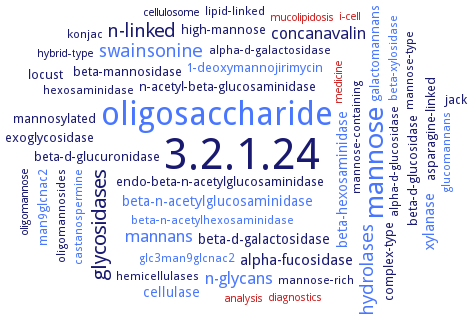3.2.1.24: alpha-mannosidase
This is an abbreviated version!
For detailed information about alpha-mannosidase, go to the full flat file.

Word Map on EC 3.2.1.24 
-
3.2.1.24
-
oligosaccharide
-
mannose
-
glycosidases
-
n-linked
-
swainsonine
-
hydrolases
-
mannans
-
n-glycans
-
concanavalin
-
alpha-fucosidase
-
xylanase
-
beta-n-acetylglucosaminidase
-
beta-d-galactosidase
-
beta-hexosaminidase
-
cellulase
-
endo-beta-n-acetylglucosaminidase
-
high-mannose
-
beta-d-glucosidase
-
galactomannans
-
1-deoxymannojirimycin
-
asparagine-linked
-
jack
-
beta-mannosidase
-
exoglycosidase
-
mannosylated
-
man9glcnac2
-
n-acetyl-beta-glucosaminidase
-
locust
-
beta-d-glucuronidase
-
complex-type
-
glucomannans
-
konjac
-
mannose-type
-
hemicellulases
-
glc3man9glcnac2
-
castanospermine
-
oligomannosides
-
alpha-d-galactosidase
-
alpha-d-glucosidase
-
mannose-rich
-
beta-xylosidase
-
lipid-linked
-
hexosaminidase
-
beta-n-acetylhexosaminidase
-
mannose-containing
-
hybrid-type
-
i-cell
-
mucolipidosis
-
oligomannose
-
analysis
-
cellulosome
-
diagnostics
-
medicine
- 3.2.1.24
- oligosaccharide
- mannose
- glycosidases
-
n-linked
- swainsonine
- hydrolases
- mannans
- n-glycans
-
concanavalin
- alpha-fucosidase
- xylanase
- beta-n-acetylglucosaminidase
- beta-d-galactosidase
- beta-hexosaminidase
- cellulase
-
endo-beta-n-acetylglucosaminidase
-
high-mannose
- beta-d-glucosidase
- galactomannans
- 1-deoxymannojirimycin
-
asparagine-linked
-
jack
- beta-mannosidase
-
exoglycosidase
-
mannosylated
- man9glcnac2
- n-acetyl-beta-glucosaminidase
-
locust
- beta-d-glucuronidase
-
complex-type
- glucomannans
-
konjac
-
mannose-type
-
hemicellulases
- glc3man9glcnac2
- castanospermine
-
oligomannosides
- alpha-d-galactosidase
- alpha-d-glucosidase
-
mannose-rich
- beta-xylosidase
-
lipid-linked
- hexosaminidase
- beta-n-acetylhexosaminidase
-
mannose-containing
-
hybrid-type
- i-cell
- mucolipidosis
-
oligomannose
- analysis
- cellulosome
- diagnostics
- medicine
Reaction
Synonyms
1,2-alpha-D-mannosidase, 1,2-alpha-mannosidase, acid alpha-mannosidase, acidic alpha-mannosidase, alpha 1,2-mannosidase, Alpha mannosidase 6A8B, alpha-1,2-mannosidase, alpha-1,3 mannosidase, alpha-1,4 mannosidase, alpha-D-mannopyranosidase, alpha-D-mannosidase, Alpha-D-mannoside mannohydrolase, alpha-man, alpha-mann, alpha-mannosidase, alpha-mannosidase C, alpha-mannosidase E-II, alpha-mannosidase I, alpha-mannosidase IA, alpha-mannosidase II, alpha-mannosidase III, alpha1,2-mannosidase, AMAN, class II alpha-mannosidase, CpGH125, ER-alpha-mannosidase, ER-mannosidase II, exo-alpha-mannosidase, GH38 alpha-mannosidase, GH38 alpha-mannosidase II, GH38 class II alpha-mannosidase, GH38 enzyme, Golgi alpha-mannosidase II, Golgi mannosidase IA, Golgi mannosidase IB, Laman, Lysosomal acid alpha-mannosidase, lysosomal alpha-D-mannosidase, lysosomal alpha-mannosidase, Man1p, MAN2B1, Man2C1, Man2C1 alpha-mannosidase, ManA, mannanase, MGG_00994.6, More, neutral alpha-mannosidase, neutral/cytosol mannosidase, p-nitrophenyl-alpha-mannosidase, SpGH125, SpGH38, Ssa-man, SSO3006, TM1851, TMM, velmanase alfa


 results (
results ( results (
results ( top
top






